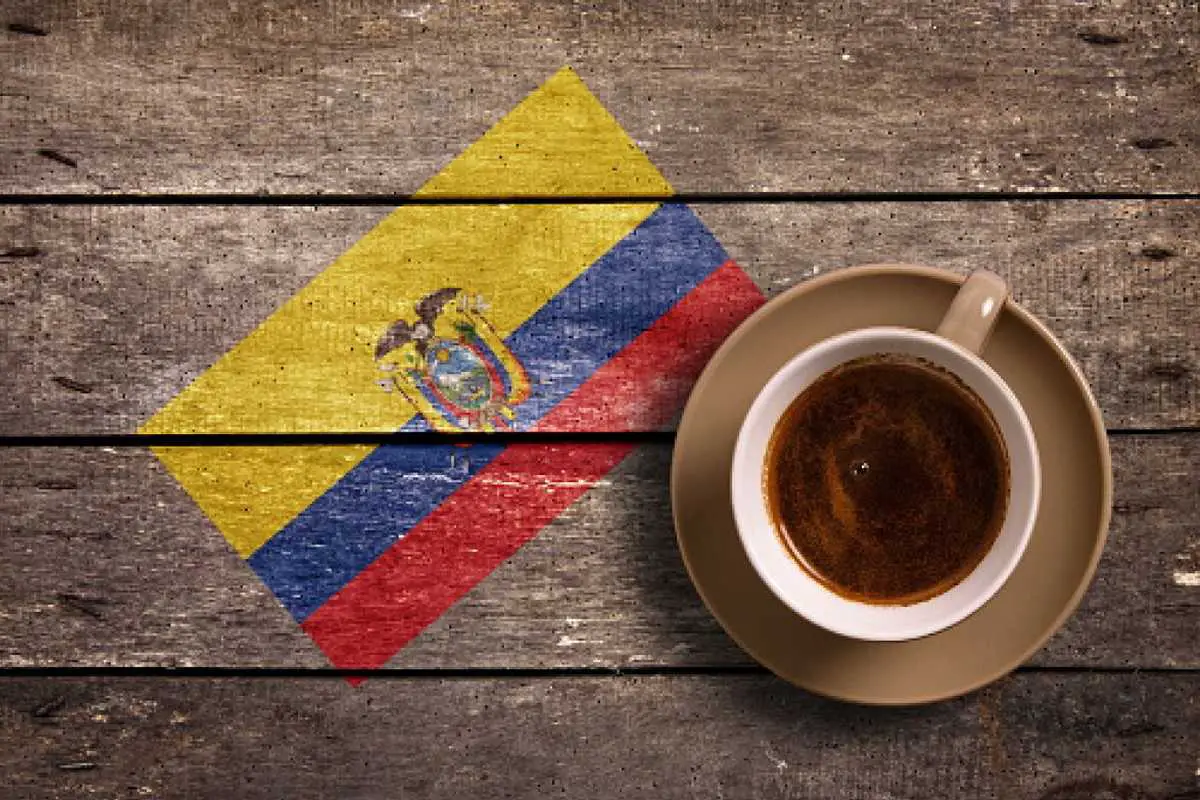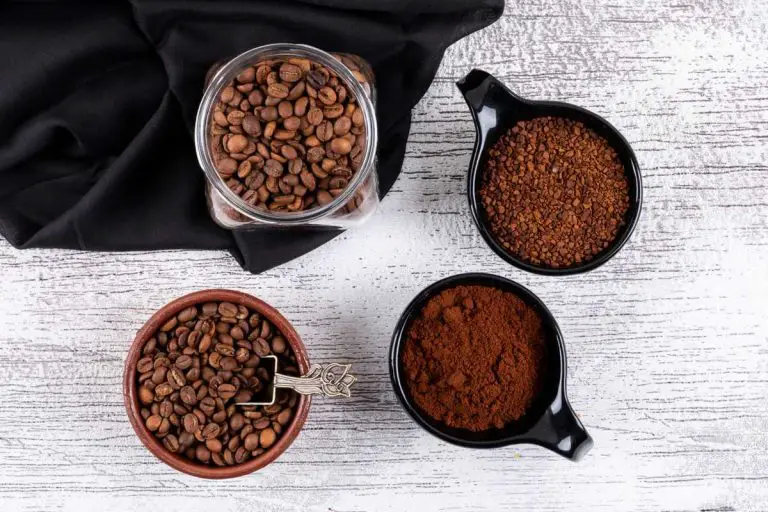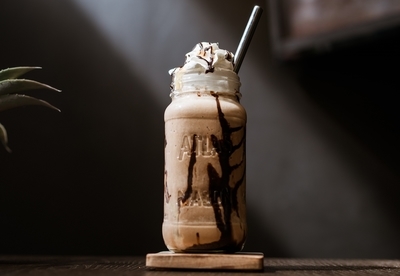The Complete Guide to Colombian Coffee (The World’s Best)
No doubt you’ve seen ‘100% Colombian Coffee’ on coffee packet labels at the supermarket. Colombian coffee stands apart in the minds of coffee consumers as something special. But why? What is Colombian coffee exactly? Explore our guide to Colombian coffee and discover its unique qualities, superior Arabica beans, and rich flavors that make it a standout choice.
Colombian coffee is coffee that is grown in Colombia. The coffee tends to demand a higher price because it is mostly made up of the superior arabica variety. Colombian coffees can have heavy notes of chocolate and nuts, or lighter fruit and floral notes, depending on which department it’s grown.
The Colombian Coffee Growers Federation (Federación Nacional de Cafeteros) actively works to promote its coffee1. So is Colombian coffee any good, or is it just marketing?
What is Colombian coffee?
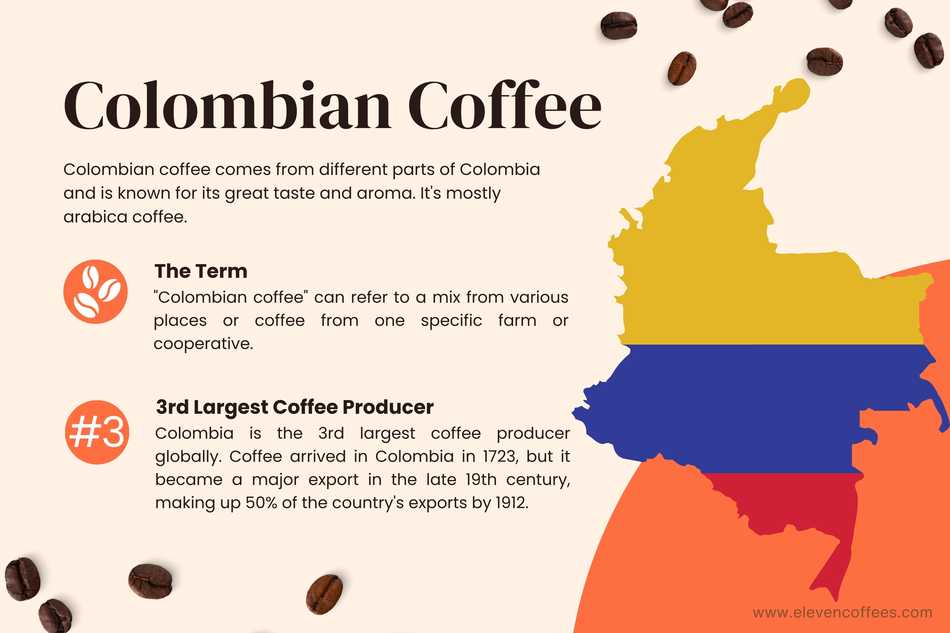
Colombian coffee is coffee that has been grown in the various departments within Colombia. It is not its own variety of coffee bean. Colombian coffee is prized for its excellent flavour and aroma as almost all the coffee grown is of the arabica variety.
Coffee packets that have been labelled as Colombian coffee may be a blend of various coffees from throughout Colombia or a single origin. Single-origin Colombian coffee is coffee that has been produced by and traceable from one single farm or cooperative in Colombia.
Colombia is the third-highest producer of coffee behind Brazil and Vietnam. Coffee was probably first introduced to Colombia in 1723 by the Jesuits. The spread was initially very slow and didn’t become significant until the end of the 19th-century. By 1912, coffee beans made up a whopping 50% of Colombia’s total exports.[2]
Many packets of coffee containing Colombian coffee also contain the words Supremo and Excelso on the packet.
Supremo and Excelso is a reference to the size of the coffee bean[3]. It has no relation to the quality of the coffee nor of its traceability to certain areas in Colombia.
What is the difference between Colombian coffee and regular coffee?
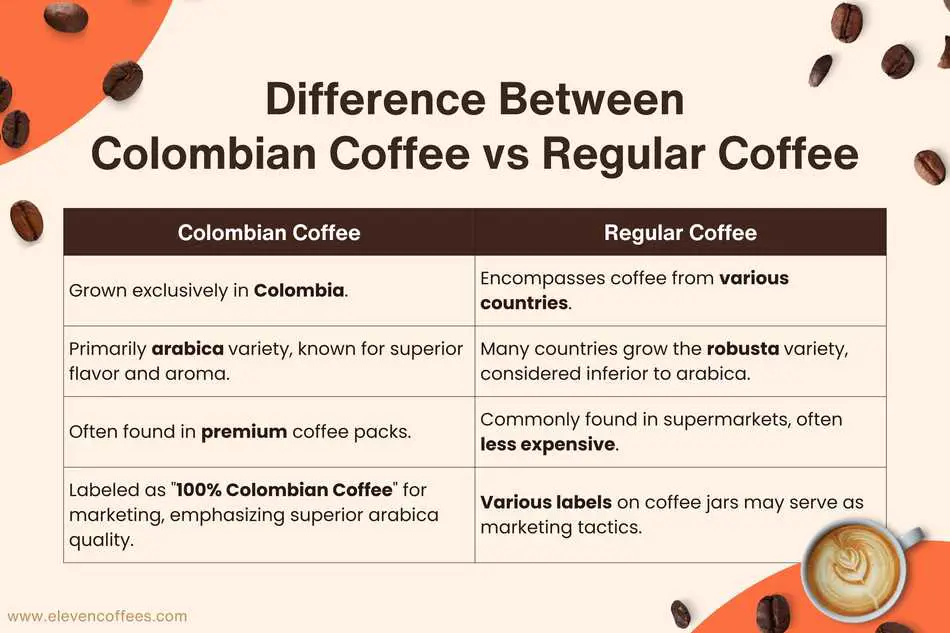
You could say that Colombian coffee is regular coffee. It isn’t a type of coffee bean, roast profile, or brew method. Colombian coffee is just coffee that has been grown within the borders of Colombia.
You’ll find Colombian coffee often used in more premium packs of coffee at places like the supermarket. This is because Colombian coffee is made up of the superior arabica variety whilst a lot of other coffee-producing countries grow the inferior robusta. When coffee is 100% arabica, it demands a higher price due to its superior quality.
The confusion between Colombian coffee and other types of coffee arises due to the packet labels on coffee. The words ‘100% Colombian Coffee’ on your coffee jar or packet are used by the Federación Nacional de Cafeteros (FNC) of Colombia and are no more than a marketing ploy to stand apart as something special in the minds of coffee consumers.
Just think of times when you’ve seen wording such as ‘Morello cherries’, or ‘Italian lemons’ on a packet of food. Your mind instantly thinks that it’s something special.
Are Morello cherries superior? What about Italian lemons over Spanish ones? Nope, I thought you were none the wiser. Looks like marketing works, eh?
Despite this, there’s no doubt about the quality and the mass enjoyment of Colombian coffee throughout the world. Colombian coffees are real crowd-pleasers. They’re a lot closer to what you probably think of as coffee when comparing to African coffees, for example.
However, if you gave the majority of people a cup of coffee from Brazil, Bolivia, or Guatemala, they would probably be none the wiser.
What does Colombian coffee taste like?
Colombian coffee is what you would call a crowd-pleaser. Good quality, specialty Colombian coffee exhibits flavours such as chocolate, caramel and nuts.
This is much like you see from Brazilian coffees, but there’s more acidity. Coffee acidity is highly prized in good quality coffee as it gives the coffee a vibrant and refreshing quality.

Acidity in coffee shouldn’t be confused with sourness. Acidity is what you enjoy from a juicy apple or pineapple. Sourness is the unpleasant taste you get when you bite into fruit that hasn’t had chance to ripen.
Because of the more toned-down flavour profiles of a lot of Colombian coffees, they make the perfect coffee for mass consumption. Their balance in sweetness, acidity and body makes for many an espresso blend.
Blends for espresso are created so as to produce a balanced cup of coffee. Espresso is a concentrated coffee, and so any imbalance in flavour is magnified. Whilst this can be very enjoyable with a heavily diluted filter coffee, it’s disagreeable in espresso as all the characteristics are exaggerated.
But rounded, heavier coffee isn’t all that Colombia produces. Colombia actually has a huge variety of flavour profiles. You will also find vibrant and fruity coffees with flavours such as tomato and berries as well as ones with floral and jammy notes.
Colombian coffees really do provide something for everyone, which is why they’re so popular.
Is Colombian coffee the best?
The vast majority of coffee grown in Colombia is of the arabica variety. When compared to huge coffee-producing nations such as Vietnam that produce vast quantities of the inferior robusta variety, you can definitely say that Colombian arabica is better.
The Colombian climate is one of the most suited to coffee in the world, too. As the world’s climate changes and becomes more and more erratic, coffee-producing countries such as Vietnam are suffering[4]. Thankfully, the climate in Colombia is a lot more stable.
Unlike many African and Asian coffees that undergo dry (natural) processing, most Colombian coffees use wet (washed) processing. Coffee experts regard washed-processed coffee more highly than natural-processed coffee because it showcases the coffee’s terroir (where it is grown) and results in more pleasing acidity.
However, to answer the question as to whether Colombian coffee is the best, well that’s a tricky one to answer. You would definitely struggle to find someone who doesn’t appreciate Colombian coffee due to the sheer diversity of its flavors.
But calling Colombian coffee the best would be like saying chocolate is better than ice cream. Ohh, chocolate ice cream!
For the uninitiated, Colombian coffee is closer to what you might think of as coffee. For that reason, most espresso blends and many specialty coffee shops shy away from using coffees from African countries such as Ethiopia or Kenya because of their ‘whacky’ flavours. A lot of African coffees can be more akin to a tea than they are coffee.
It all comes down to preference at the end of the day. A lot of the crowd-pleasing chocolatey and nutty coffees are truly delicious. But as you delve deeper into coffee, you grow to appreciate less traditional flavours such as berries, dried fruits or floral-tasting coffees.
Is Colombian coffee dark roast?
Colombian coffee can be any roast you like: be it light, medium, dark, French or Italian roast. Often times, coffee is roasted darkly to mask poor quality beans which results in bitterness.
For a real experience of Colombian coffee, go for a light or medium roast. You want to be able to detect the beautiful flavours inherent in the beans. Never buy darkly roasted coffee as your coffee will be bitter.
What is the difference between Colombian and French roast coffee?
There seems to be confusion around roasting terms when it comes to Colombian and French roast. Unlike French roast[5], Colombian is not a reference term for a type of roast profile used in the industry. You may see ‘Colombian roast’ on a packet, but it’s no more than marketing garbage.
French roast, a term primarily used in North America, is one of the four main types that high-volume commercial roasters use to describe coffee roasted very darkly, with oils visible on the surface.
The result is an extremely bitter cup and isn’t one you’ll find among specialty coffee roasters. The coffee is roasted to this level to mask inferior flavours that are found in cheap, low-grade coffees, as well as to provide uniformity when using so many different coffees in their blends.

Does Colombian coffee have more caffeine?
100% arabica Colombian coffee doesn’t have significantly more or less caffeine than arabica coffee from other countries[6].
Robusta coffee naturally contains more caffeine than arabica coffee[7]; however, Colombia doesn’t produce robusta coffee at any significant volume.
Huila

It’s hard not to mention Huila when talking about Colombian coffee. Huila is a coffee-producing department of Colombia.
For many, this is the region for great Colombian coffees and a favourite among many a barista. Coffee from Huila is a regular winner of the Colombian Cup of Excellence awards.
It’s so damned good that in 2013 it gained the Denomination of Origin status[8].
Most coffee undergoes washed processing, which purists in the coffee industry enjoy because they want to experience the inherent qualities of the coffee bean.
The reason the coffee from the Huila department is so good is because of the climate. The farms enjoy temperatures of between 17°C – 23°C (63°F – 73°F), the Goldilocks of temperatures for coffee. Most of the farms are at elevations of 1,200 – 1,800m (3,900 – 5,900ft) which is ideal for arabica. Throw in the nitrogen-rich volcanic soil and, voila, you’ve got great coffee.[9]
Also, because so many of the coffee farms are just 1.5 hectares (18,000 square yards) in size and use their own wet mills to process the coffee cherries, the focus is more on quality than quantity.[9]
35 of the 37 municipalities in Huila produce coffee[9], with the most notable being Pitalito, Garzón, La Plata, and Neiva.
How to make Colombian coffee
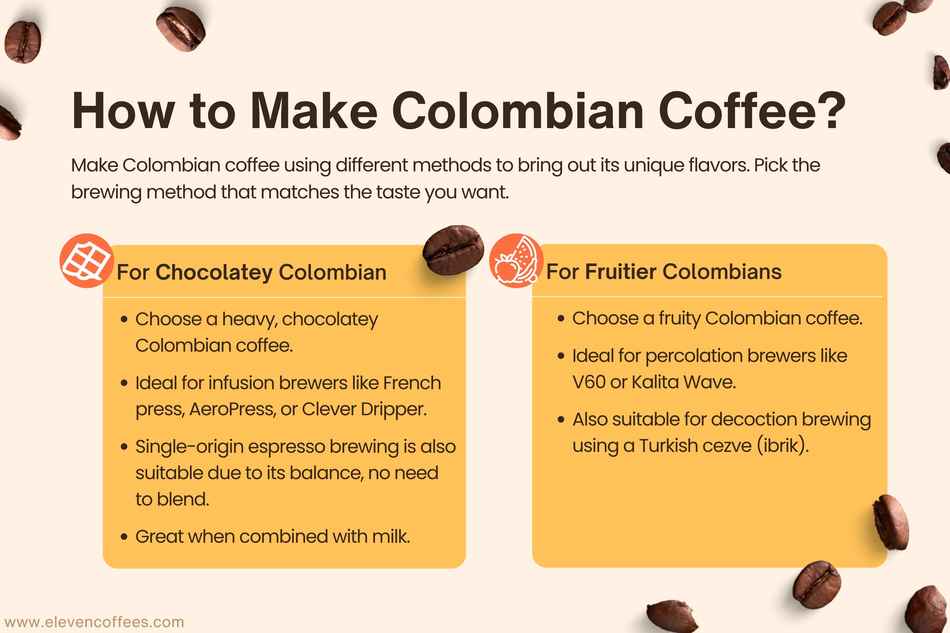
Colombian coffee suits any brewing apparatus from infusion brewers to percolation to espresso to Turkish (decoction).
For a chocolatey Colombian, try an infusion brewer such as the French press, AeroPress, or Clever Dripper. Heavy, chocolatey Colombians can sometimes work great as single-origin espresso. The balance means there’s no need to blend. Colombians brewed with infusion brewers go great with milk.
For fruitier Colombians, try a percolation brewer such as a V60 or Kalita Wave to highlight the delicate flavours. Fruity Colombians are also great for decoction brewing using a Turkish cezve (ibrik).
Colombian coffee facts
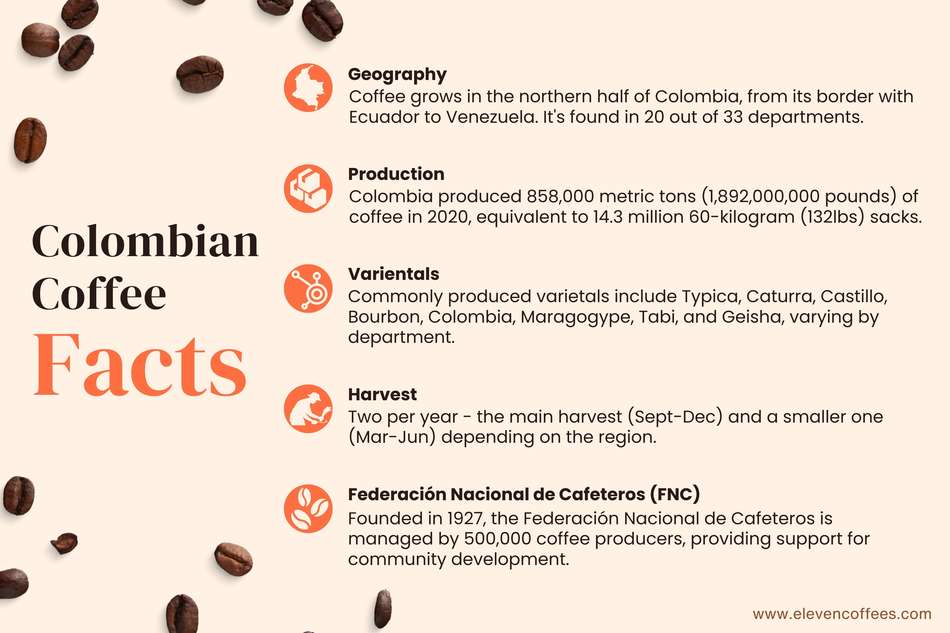
Geography
Colombia produces coffee throughout the northern half, stretching from its southeastern border with Ecuador to its northwestern border with Venezuela. Coffee is grown in 20 of the 33 departments that make up the country.
Of the 20 departments that produce coffee in Colombia[10], the most notable are Cauca, Valle del Cauca, Tolima, Huila, Quindio, Risaralda, Nariño, Caldas, Antioquia, Cundinamarca, Santander, Norte de Santander, and Sierra Nevada.
Production
In 2020, Colombia produced 858,000 metric tons (1,892,000,000 pounds) of coffee. That’s 14.3 million 60-kilogram (132lbs) sacks of coffee.
Varietals
The most commonly produced varietals in Colombia are Typica, Caturra, and Castillo. You will also find Bourbon, Colombia, Maragogype, Tabi, and even Geisha. These varietals are produced in varying degrees depending on the department.[11]
Harvest
Colombian coffees produce two harvests each year[12]. The main harvest and the smaller mitaca harvest. The majority of the main harvest takes place between September and December with some between March and June. Harvest time depends on the geographical region.
Federación Nacional de Cafeteros
The FNC was created in 1927 and is controlled by its 500,000 coffee-producing members[13]. As well as marketing, the FNC provides coffee-growing communities with roads, schools and health centres[2].
References
[2]The World Atlas of Coffee by James Hoffmann.

